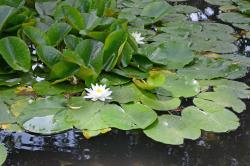Perennial, rhizomes short, thick, erect (caudex-like) or horizontal. Stolons present or absent. Leaves spiral, stipulate; petioles with large air canals; lamina with primary venation palmate and anastomosing lateral veins, submerged, floating or emergent; leaf bases deeply cordate to sagittate. Flowers broad, perianth perigynous; 4 outer green or reddish sepaloid tepals; numerous inner tepals, often transitions between tepals and stamens, staminodes absent; nectaries absent; protogynous, diurnal or nocturnal opening. Stamens laminar; anther dehiscence introrse; pollen monoaperturate, tectum imperforate, exine surface echinate to smooth. Ovary syncarpic or partially free in a cup-shaped receptacle, semi-inferior, stigmatic processes covered with secretary multicellular, uniseriate papillae. Fruit berry-like, fleshy and spongy; submergent maturation, irregularly dehiscent. Seeds with inflated arils, numerous, dispersal hydrochory.
Nymphaea is the most diverse group in the Nymphaeales, with five traditionally defined subgenera based on morphology (Conrad 1905). The subgenera are largely recovered within three major evolutionary lineages in analyses of molecular data (Borsch et al. 2008; 2011, Löhne et al. 2007). Nymphaea subgenus Nymphaea contains mostly northern temperate species from Eurasia and North America that are diurnal flowering, syncarpic, have un-appendaged anthers, ligulate carpellary styles, and flower colour mostly white, pink or red, rarely yellow. The northern water lilies are known as cold tolerant or ‘hardy’, and many cultivars grown in New Zealand are from this group as well as the two naturalised species. Species of Nymphaea subgenus Brachyceras are pan-tropical and close to the Australian and New Guinean endemic subgenus Anecphya (Borsch et al. 2008, 2011; Löhne et al. 2007). These two subgenera also have diurnally flowering species, but they all have partly free carpels, appendaged anthers, thick, fleshy carpellary styles, and their flower colour is blue, mauve, pink, white and occasionally yellow. The two remaining subgenera are Hydrocallis (neo-tropical/sub-tropical) and Lotos (paleo-tropical/temperate); they are mostly nocturnal flowering species, are syncarpic, have un-appendaged anthers, but distinctive long stylar processes, and flower colour is mostly white to cream, pink, red and pale yellow. An evolutionary trend within the night bloomers is for large, broad flowers with more stamens and carpels, possibly associated with beetle pollination (Borsch et al. 2008; Löhne et al. 2007).
Two subgenera are represented in New Zealand by naturalised species, N. alba and N. mexicana, in subgenus Nymphaea and N. capensis in subgenus Brachyceras. The other subgenera are present in ornamental cultivations, both by species and hybrid cultivars (Champion & Clayton 2001). Hybridisation is mostly restricted between species within the same subgenus (Conrad 1905; Wood 1959; Löhne et al. 2007). The cultivars of Nymphaea are many and diverse and the origins are generally unknown.
Names in brackets are species not naturalised but present in cultivation.
| 1 | Flowers white, blue or pink; stolons absent | 2 |
| Flowers yellow; stolons present with brood bodies | N. mexicana | |
| 2 | Flowers blue; stamens appendaged | N. capensis |
| Flowers white, pinkish, red, occas. yellow; stamens non-appendaged | 3 | |
| 3 | Leaves crowded on rhizome; flowers faintly scented or odourless | N. alba |
| Leaves scattered on rhizome; flowers often strongly scented | [N. odorata] |
The species of Nymphaea have large, showy, wide-opening flowers (with diurnal or nocturnal opening/closing times) of various colours and a fleshy, globose, berry-like fruit, which matures below the water surface. The seeds are surrounded by inflated arils (unlike Nuphar).
About 40 species, almost cosmopolitan. Absent naturally in New Caledonia, New Zealand and across the Pacific Islands, but now naturalised in all these places.
| Category | Number |
|---|---|
| Exotic: Fully Naturalised | 2 |
| Exotic: Casual | 1 |
| Total | 3 |
Chromosome counts indicate a base number of x = 14 (Borsch et al. 2008).
The water lilies are rhizomatous and root in soft, organic sediments of still and slow-flowing waters. Flowers in Nymphaea are generally protogynous and insect pollinated, with copious stigmatic fluid on the stigmatic surface when functionally female on the first day or night of opening. The three New Zealand naturalised species are diurnal, opening during the day and closing at night (for three or four consecutive days), after which the flowers are pulled below the surface of the water on a bending or coiling peduncle. The fruits ripen and decay underwater, irregularly bursting and releasing seeds, which are within inflated, mucilaginous arils.
Nymphaea odorata (fragrant white water lily) type rhizomes are known from collections in New Zealand, and there are also other species in cultivation, including N. candida (dwarf white water lily). These species and hybrid cultivars have been deliberately introduced into natural waterbodies in New Zealand. In persistent plantings of Nymphaea, it is difficult to distinguish between a cultivated relic and naturalisation. In some hybrid cultivars and species, the former is likely, as they do not set seed or have detachable tubers, and although expanding clonally they are unable to spread between waterbodies and are reliant upon human-assisted establishment.




